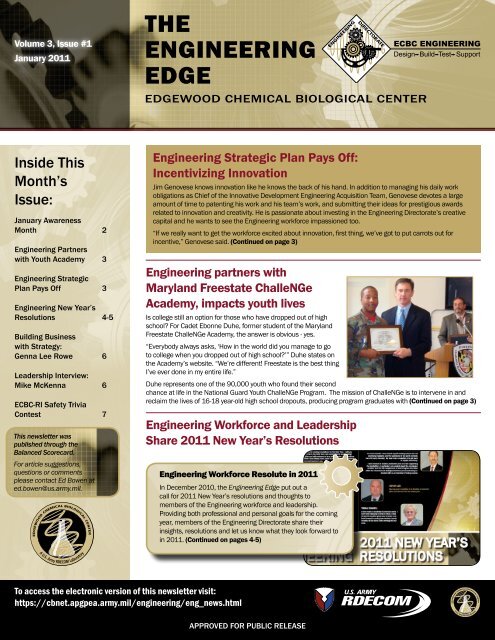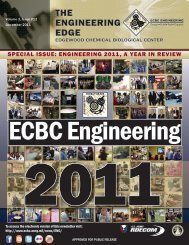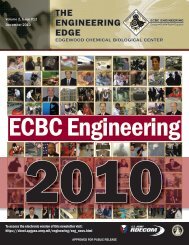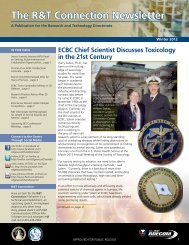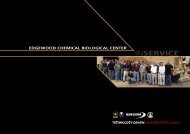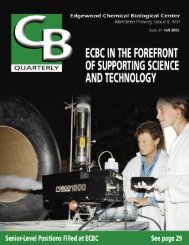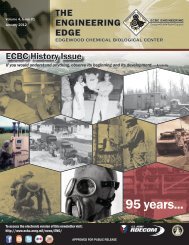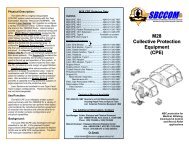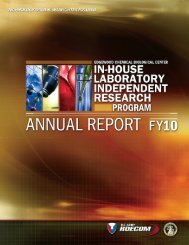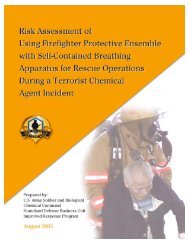The engineering edge - Edgewood Chemical Biological Center ...
The engineering edge - Edgewood Chemical Biological Center ...
The engineering edge - Edgewood Chemical Biological Center ...
You also want an ePaper? Increase the reach of your titles
YUMPU automatically turns print PDFs into web optimized ePapers that Google loves.
Volume 3, Issue #1<br />
January 2011<br />
<strong>The</strong><br />
Engineering<br />
Edge<br />
EdgeWood <strong>Chemical</strong> <strong>Biological</strong> <strong>Center</strong><br />
Inside This<br />
Month’s<br />
Issue:<br />
January Awareness<br />
Month 2<br />
Engineering Partners<br />
with Youth Academy 3<br />
Engineering Strategic<br />
Plan Pays Off 3<br />
Engineering New Year’s<br />
Resolutions 4-5<br />
Building Business<br />
with Strategy:<br />
Genna Lee Rowe 6<br />
Leadership Interview:<br />
Mike McKenna 6<br />
ECBC-RI Safety Trivia<br />
Contest 7<br />
This newsletter was<br />
published through the<br />
Balanced Scorecard.<br />
For article suggestions,<br />
questions or comments<br />
please contact Ed Bowen at<br />
ed.bowen@us.army.mil.<br />
Engineering Strategic Plan Pays Off:<br />
Incentivizing Innovation<br />
Jim Genovese knows innovation like he knows the back of his hand. In addition to managing his daily work<br />
obligations as Chief of the Innovative Development Engineering Acquisition Team, Genovese devotes a large<br />
amount of time to patenting his work and his team’s work, and submitting their ideas for prestigious awards<br />
related to innovation and creativity. He is passionate about investing in the Engineering Directorate’s creative<br />
capital and he wants to see the Engineering workforce impassioned too.<br />
“If we really want to get the workforce excited about innovation, first thing, we’ve got to put carrots out for<br />
incentive,” Genovese said. (Continued on page 3)<br />
Engineering partners with<br />
Maryland Freestate ChalleNGe<br />
Academy, impacts youth lives<br />
Is college still an option for those who have dropped out of high<br />
school For Cadet Ebonne Duhe, former student of the Maryland<br />
Freestate ChalleNGe Academy, the answer is obvious - yes.<br />
“Everybody always asks, ‘How in the world did you manage to go<br />
to college when you dropped out of high school’” Duhe states on<br />
the Academy’s website. “We’re different! Freestate is the best thing<br />
I’ve ever done in my entire life.”<br />
Duhe represents one of the 90,000 youth who found their second<br />
chance at life in the National Guard Youth ChalleNGe Program. <strong>The</strong> mission of ChalleNGe is to intervene in and<br />
reclaim the lives of 16-18 year-old high school dropouts, producing program graduates with (Continued on page 3)<br />
Engineering Workforce and Leadership<br />
Share 2011 New Year’s Resolutions<br />
Engineering Workforce Resolute in 2011<br />
In December 2010, the Engineering Edge put out a<br />
call for 2011 New Year’s resolutions and thoughts to<br />
members of the Engineering workforce and leadership.<br />
Providing both professional and personal goals for the coming<br />
year, members of the Engineering Directorate share their<br />
insights, resolutions and let us know what they look forward to<br />
in 2011. (Continued on pages 4-5)<br />
To access the electronic version of this newsletter visit:<br />
https://cbnet.apgpea.army.mil/<strong>engineering</strong>/eng_news.html<br />
..<br />
APPROVED FOR PUBLIC RELEASE
Page 2<br />
For more information about your HR policies, please contact Engineering<br />
Workforce Management Representative Sabre Harper at ext. 5-2722.<br />
ECBC Safety Tip of the Month:<br />
WINTER DRIVING<br />
Did you miss last<br />
month’s issue of the<br />
Engineering Edge<br />
Download previous<br />
issues of the Edge<br />
from SharePoint at:<br />
https://<br />
ecbcsharepoint.<br />
apgea.army.mil/<br />
sites/<strong>engineering</strong>/<br />
<strong>edge</strong>/<br />
ECBC Engineering Directorate HR Tip<br />
of the Month: Thrift Savings Plan<br />
No contributions can be made to the Thrift Savings Plan (TSP) while on leave<br />
without pay or separated from the civilian position. However, if the employee<br />
is restored to his/her civilian position, retroactive contributions and TSP<br />
elections may be made to cover that period of service. Employees interested<br />
in making retroactive contributions must contact their servicing Customer<br />
Service Representative, Linda Pineiro, to set up a payment plan.<br />
From Car Talk, at www.cartalk.com.<br />
Winter driving presents a number of challenges to both you and your<br />
car. Cold weather tests the limits of your car’s mechanical abilities.<br />
Treacherous driving conditions test your abilities as a driver. What<br />
can you do to get ready for the snow and sleet-covered roads and<br />
dipstick-freezing temperatures Here are several tips to stay safe.<br />
SAFETY TIPS<br />
1. Get a tuneup<br />
2. Check battery, coolant and wipers<br />
3. Fill your fuel tank and washer fluid<br />
4. Check rear defrost<br />
5. Carry first aid supplies<br />
6. Have a phone<br />
7. Clean off your car<br />
8. Go slow<br />
January Awareness Month:<br />
Blindness Prevention<br />
January is National Glaucoma Awareness Month, and an important time to<br />
spread the word about this sight-stealing disease.<br />
Glaucoma is the leading cause of preventable blindness. Everyone, from<br />
infants to seniors, is vulnerable. Over 4 million Americans, and nearly 70<br />
million people worldwide, have glaucoma. Experts estimate that half of<br />
them don’t know they have it. Combined with our aging population, we can<br />
see an epidemic of blindness looming if we don’t raise awareness about<br />
the importance of regular eye examinations to preserve vision.<br />
In the United States, approximately 120,000 are blind from glaucoma,<br />
accounting for 9 percent to 12 percent of all cases of blindness. Half of the<br />
people affected by glaucoma don’t know they have it. Here are three ways<br />
to help raise awareness:<br />
1. Talk to friends and family about glaucoma. If you have glaucoma, don’t<br />
keep it a secret. Let your family members know.<br />
2. Refer a friend to the Glaucoma Research Foundation web site,<br />
www.glaucoma.org.<br />
3. Request to have free educational booklets sent to you or a friend.<br />
You can also connect with the Glaucoma Research Foundation on<br />
Facebook for regular updates on glaucoma research, treatments, news and<br />
information.<br />
<strong>The</strong> Engineering Edge<br />
<strong>The</strong> Engineering Edge is the<br />
ECBC Engineering Directorate‘s monthly<br />
newsletter. It is produced for ECBC<br />
Engineering staff as part of the Balanced<br />
Scorecard Initiative. Unless otherwise noted,<br />
all stories, photographs and graphics are<br />
produced by the Engineering Directorate‘s<br />
Strategic Planning and Business Operations<br />
Branch.<br />
Submissions: We need your stories,<br />
photographs, comments and suggestions.<br />
If interested, contact <strong>The</strong> Engineering<br />
Edge staff concerning ongoing and<br />
future products and submissions to <strong>The</strong><br />
Engineering Edge Newsletter. Submit your<br />
stories or ideas via e-mail to<br />
ed.bowen@us.army.mil.<br />
APPROVED FOR PUBLIC RELEASE
Page 3<br />
<strong>The</strong> decision paper to institute<br />
an innovation incentive program<br />
at ECBC was signed by all ECBC<br />
Directors in February 2010.<br />
Incentivize Innovation (Continued from page 1)<br />
In order to add “carrots” and encourage ECBC employees to generate this creative capital, Genovese leveraged the<br />
Engineering Directorate’s Balanced Scorecard (BSC) strategy and Engineering leadership’s support of the strategy to<br />
push his cause into the limelight – he volunteered for the Engineering BSC initiative P5 team, “Incentivize Innovation.”<br />
<strong>The</strong> P5 team members include Genovese, Bob Pazda, Lester Strauch, and Mark Schlein. <strong>The</strong> focus of the initiative<br />
is to “demystify motivation” and provide tangible, valuable incentives that will encourage the workforce to contribute<br />
creative capital. By fostering creative intelligence, the P5 team believes individuals will be more likely to take on<br />
a greater sense of self-empowerment and a new personal vision, resulting in an improved “quality of life” for the<br />
workforce.<br />
“’Incentivizing Innovation’ [P5] has been a great success so far,” Genovese said. “<strong>The</strong> final phase of increasing awards<br />
for invention disclosures and issued patents is now complete. <strong>The</strong>re is a trackable system established within the<br />
Patent Legal Office to write justification for the incentive awards and issue the increased incentive award checks once<br />
paperwork is received.”<br />
<strong>The</strong> team’s effort to institute an innovation incentive program at ECBC included a detailed decision paper in which<br />
Genovese outlined the proposed process and reasons for establishing the program. <strong>The</strong> paper was signed by the<br />
ECBC Directors, including the ECBC Technical Director, Joseph Wienand.<br />
“New patents can produce technologies that aid the warfighter and emergency responders, develop the professional<br />
credentials of the patent holders, provide numerous<br />
awards opportunities, and produce royalties,”<br />
Genovese states in the ECBC Innovation Incentives<br />
Decision Paper. “But the patent process is difficult,<br />
and patent incentives have always been low. Improving ECBC innovation is now addressed<br />
comprehensively in the ECBC and Engineering Directorate organizational strategies, and<br />
improving innovation incentive is a key initiative of this effort.”<br />
In addition to the P5 team’s work to increase awards for invention disclosures and issued<br />
patents, Genovese is teaming with the Directorate of Program Integration’s Mary Martinez<br />
to launch a second stage of the P5 initiative, apply monetary incentives to honorary awards<br />
dealing with technology development-transfer and scientific research innovation.<br />
“In working on the BSC P5 Initiative, Mary and I found that you can give honorary and monetary<br />
awards for the same project; but there’s never been a precedent set to give cash for the same<br />
act that someone receives an honorary award for,” Genovese said.<br />
According to the Army Regulation AR 672-20, and a review by RDECOM’s legal office, both<br />
monetary and honorary awards can be given for the same act. Based on this positive<br />
consensus, Genovese and Martinez are moving ahead in a similar fashion with discussions<br />
and decision papers to incentivize honorary awards that are technology based.<br />
Genovese had a chance to rally Engineering Directorate leadership and workforce employees<br />
around this second stage of P5 during November’s Engineering Strategic Management<br />
Meeting. <strong>The</strong> meeting proved to be a valuable opportunity for Genovese to communicate to<br />
both leadership and the workforce the importance and progress of the P5 work.<br />
(Continued on page 7)<br />
Engineering Partners With Youth Academy (Continued from page 1)<br />
APPROVED FOR PUBLIC RELEASE<br />
THANK<br />
YOU!<br />
You spoke and we listened! Thank you for your<br />
feedback in October regarding how we can<br />
better improve the content of the Engineering<br />
Edge. In response to requests for more stories<br />
related to career opportunities and growth,<br />
we’ve included an article about the Engineering<br />
Directorate’s efforts to educate the workforce<br />
on invention dislosures, patents and the<br />
incentives for continuing to develop creative<br />
capital. We hope you enjoy the article! We will<br />
continue to feature similar series in future issues.<br />
And as always, we welcome your feedback and<br />
article suggestions for future issues. To submit<br />
story ideas, please contact Ed Bowen at<br />
ed.bowen@us.army.mil.<br />
skills, education, and self-discipline necessary to succeed as productive citizens. As one of the original 10 states to embrace ChalleNGe, the State of Maryland<br />
endorsed the program in 1993 and formed a cooperative agreement between the Maryland National Guard and the National Guard Bureau. Today, 27 states<br />
have launched their own respective ChalleNGe programs.<br />
For the past eight years, ECBC’s Engineering Directorate has partnered with the Maryland Academy, impacting the lives of at-risk youth and instilling in them a<br />
renewed sense of purpose and direction. Located on the Aberdeen area of Aberdeen Proving Ground (APG) in Harford County, Maryland, the Academy expressed<br />
an interest in partnering with their “neighbor” ECBC as a participant in the Job Skills component of the program.<br />
“Around 2002, I was told about the program by a colleague who also informed me that they were looking for partnerships whereby they could get a few of their<br />
top students some work experience, prior to graduation, to boost their resume,” Bill Klein, Engineering Associate Director, said.<br />
Klein made arrangements to visit the Academy at APG immediately and was overwhelmingly impressed by the quality of the program and the dedication of the<br />
youth.<br />
“I met several cadets and agreed on the spot to set something up for members from that class to come work in the Engineering Advanced Design and<br />
Manufacturing (ADM) Division prior to their graduation,” Klein said.<br />
In December of that year, the first four cadets worked in Engineering’s ADM Division and based on the success of their experience, Klein expanded the<br />
Directorate’s involvement for the next session to also place cadets in the Engineering Test Division.<br />
This year, Mark Schlein, Chief of ADM Division, hosted class number 35 as a part of the Academy’s Job Skills component. Classes of six to eight cadets are hosted<br />
in the Division twice a year, working on site to develop technical and functional job skills that they can apply in a workplace setting, (Continued on page 8)
Page 4<br />
Mark Ciampaglio<br />
I made a New Year’s resolution years ago never to make<br />
another New Year’s resolution; it’s the only one I’ve ever<br />
kept. I’m most looking forward to watching my babies grow<br />
in the next year; my oldest just turned 2 in December and my<br />
youngest is 5 months. I can’t wait to see what they’ll do/learn/<br />
say next.<br />
AJAY THORNTON<br />
I am not one for making resolutions for the New Year. I will say<br />
however; that in the New Year I am committed to accentuating<br />
the positive and will endeavor to be a better leader. I will continue<br />
to do what I have always done, seek to make a positive difference<br />
wherever and however I can.<br />
SABRE HARPER<br />
This upcoming year I am going to be more<br />
devoted to my church.<br />
joe domanico<br />
1. Place additional emphasis on Technical efforts and<br />
consolidate administrative requirements and actions<br />
to provide the customer a better price and product.<br />
2. Increase efficiency of technical operations to be<br />
able to provide additional customers with quality<br />
products in FY11 and beyond.<br />
3. Expand our team knowl<strong>edge</strong> base and potential<br />
customer awareness through attendance at<br />
conferences and formal classes.<br />
4. Diversify our technical capabilities to allow us to accept projects off of our<br />
mainstream during times of insufficient available funds in our main area of<br />
expertise.<br />
5. Improve individual health through the implementation of the Army Health<br />
Promotion Program.<br />
In December 2010, the Engineering Edge put out a<br />
call for 2011 New Year’s resolutions and thoughts to<br />
members of the Engineering workforce and leadership.<br />
Read here to find out what your colleagues are resolving<br />
and looking forward to in 2011.<br />
APPROVED FOR PUBLIC RELEASE
Page 5<br />
amanda dubbs<br />
My new year’s resolution is to pay off my husband’s student<br />
loans. I do not normally set resolutions, but this is my goal for<br />
the year. I am looking forward to seeing my sister graduate<br />
from law school in 2011 as well as celebrating my daughter’s<br />
1st birthday with families and friends.<br />
RANDY LAYE<br />
In recent months I have found myself making excuses for not<br />
exercising regularly, and the waistband of my pants reminds<br />
me of it every morning. My New Years resolution is to get back<br />
to regular exercising.<br />
I look forward to another productive year at ECBC supporting<br />
the Warfighter. In particular I am excited about the conclusion<br />
of BRAC and the full complement of Joint Program Executive<br />
Office for <strong>Chemical</strong> and <strong>Biological</strong> Defense personnel being colocated<br />
with us at Aberdeen Proving Ground.<br />
kevin lee<br />
My new year resolution is to develop an exercise<br />
plan and stick to it for the whole year.<br />
trina dowell<br />
I have made a resolution to exercise more. I<br />
have been slacking on that in 2010. I look<br />
forward to another great year at ECBC and<br />
look forward to seeing how Harford County<br />
handles all the BRAC folks moving into our<br />
area.<br />
APPROVED FOR PUBLIC RELEASE
Page 6<br />
Building Business with Strategy:<br />
A conversation with Genna Lee Rowe,<br />
Chief of Special Projects Branch<br />
<strong>The</strong> Engineering Edge talks with Genna<br />
Lee Rowe to understand why she chose<br />
to participate in the strategic planning<br />
process.<br />
Engineering Edge: How did you first hear<br />
about the Engineering Balanced Scorecard<br />
(BSC)<br />
Genna Lee Rowe: I initially heard about<br />
BSC from Suzanne Milchling and Joshua<br />
Israel. At the time I was the Business<br />
Manager for the Engineering Test Group<br />
under Ron Pojunas. I was asked to brief the BSC Core Team on the Master<br />
Planning tools I was using for the Engineering Test Group; some of them<br />
were related to customer service and surveys.<br />
EE: What initiative were you assigned when you began working on the BSC<br />
GLR: I’ve been involved in the BSC since the very early phases of the<br />
strategy’s implementation. <strong>The</strong>re were several initiatives I consulted with<br />
since there were bits and pieces of Strategic Planning work I’d done as the<br />
Business Manager for the Engineering Test Group. <strong>The</strong> initiative I primarily<br />
work on is P3, “Develop Leaders.” I work with Allen Swim, the initiative lead,<br />
and Meg Hower. That particular initiative needed some help with survey<br />
development and because of my experience in that area I thought I could<br />
be of assistance.<br />
EE: What are the main goals your initiative is trying to achieve<br />
GLR: Our P3 “Develop Leaders” team set out to come up with a<br />
comprehensive list of training needs to help our leaders excel in all of the<br />
areas we researched. Communication, actual leadership training, and<br />
customer service – these were among the different training areas we<br />
researched. Initially, we intended to establish this list of training needs<br />
then move into an implementation phase where we would coordinate the<br />
training and establish a comprehensive future plan. However, right now<br />
we are re-examining the initiative. We found that when we examined our<br />
survey results and looked at the actual trainings done, it was completely<br />
counterintuitive– the areas in which respondents had the most training<br />
were rated the lowest. We will continue to research training initiatives that<br />
would be valuable for the workforce, but we are also looking into the value<br />
of supervisors evaluating their employees individually in order to provide<br />
suggestions for how to build their team’s leadership skills. Bottom line –<br />
develop upcoming leaders to become our future leaders.<br />
EE: What inspired you to get involved<br />
GLR: Back in 2004 I was put on a detail to develop a Business Plan<br />
Evaluation Model for the ECBC Business Plan. I developed metrics to<br />
actually find out how well we were meeting our goals and looking at<br />
everything in terms of our manpower, infrastructure, funding, technology<br />
development, and how effectively we were bringing in new business and<br />
advertising the <strong>Center</strong>’s capabilities. I had the opportunity to interview and<br />
brief each of the Directors. I valued the chance to hear their perspectives<br />
and to understand how they wanted to see ECBC grow. I guess you could<br />
say I was bitten by the Strategic Planning bug back then. I was very excited<br />
when I was approached to get involved in a similar program, the BSC.<br />
EE: What has been the most rewarding part of working on the BSC<br />
GLR: I saw a great deal of potential for the BSC to be successful; that is<br />
what initially inspired me. <strong>The</strong> realized success continues to inspire me.<br />
It’s been exciting to watch the plan come to fruition, to see the tools that<br />
were developed early on take root in other initiatives, and to have the plan<br />
adopted by senior leadership and be passed outwards and upward to the<br />
<strong>Center</strong> level. I’m also inspired by the growing network of stakeholders within<br />
the Engineering Directorate that truly want to help ECBC grow.<br />
APPROVED FOR PUBLIC RELEASE<br />
Leadership Interview Series:<br />
Mike McKenna, Chief of Acquisition<br />
Logistics Division<br />
In this month’s Engineering Edge<br />
Leadership Interview Series, we talked to<br />
Michael McKenna, Chief of Acquisition<br />
Logistics Division, about his role and got<br />
him to share his thoughts on leadership.<br />
Engineering Edge: How did you start your<br />
career here at ECBC<br />
Michael McKenna: I was a local intern in<br />
1990 and was hired by the Maintenance<br />
Directorate. Ironically, the group I first<br />
worked for is the group that I work for now.<br />
Over the course of 20 years and over many sets of changes, the Acquisition<br />
Logistics Division group I work for now was actually the same set of folks I<br />
started out with in 1990.<br />
EE: What is your history with ECBC<br />
MM: I’ve always been a matrixed employee since I’ve been here. When I<br />
was in the Maintenance Directorate we were actually matrixed out to the<br />
teams, and later on we went into a teaming process. So I’ve had a history<br />
with the so-called “previous incarnations” of ECBC for 20 years.<br />
EE: What are your main roles and responsibilities<br />
MM: I’ve been the Acquisition Logistics Division Chief for three months and<br />
I’m responsible for supporting Integrated Logistics Support needs across<br />
the <strong>Center</strong> as well as for the Joint Program Managers that we support. I’m<br />
also the U.S. Army Research, Development and Engineering Command<br />
CP17 Activity Career Program Manager, which is Maintenance Materials<br />
Management. If there are any questions regarding training, support or<br />
curriculums for CP17 they come to me.<br />
EE: What is one of your most memorable highlights as a team leader<br />
MM: Watching a couple of our interns be promoted. We’ve had four interns<br />
receive promotions since I’ve been here in the Acquisition Logistics Division.<br />
EE: What have been some of the challenges you have faced during your<br />
career How did you overcome them<br />
MM: Probably one of the biggest challenges I faced was in the mid-90s<br />
when we were transitioning from Army-focused programs to joint-focused<br />
programs. We had to make a decision to select a joint service primary<br />
inventory control activity (PICA). PICA is essentially the group of individuals<br />
responsible for the sustainment and provisioning of order parts for our<br />
program; up until that time, any Army program had been designated an<br />
Army PICA. We were one of the first programs to move away from that<br />
model. It was really a challenge to make that transition because there was<br />
a lot of political backlash. However, we had the rationale to do it, and after<br />
conducting a lot of analysis, we eventually chose the Navy over the Army.<br />
We had many meetings with the parties involved and used the analysis to<br />
prove the feasibility of what we were doing. It was a tough decision, but it<br />
was the right one to make.<br />
EE: What makes you most excited about the work you do here at ECBC<br />
MM: Growing our interns here at ECBC. It is a rewarding process to watch;<br />
to see them come in, learn their craft, then go out into their respective<br />
teams to apply what they’ve learned. In particular, it’s great to see someone<br />
that is successful at what they do, come into the <strong>Center</strong>, climb up the job<br />
ladder to progress as a confident member of their team.<br />
EE: What kind of advice would you give to members of the Engineering<br />
workforce who would someday like to see themselves in a leadership<br />
position<br />
MM: I would say embrace challenges that allow you to separate yourself<br />
from the rest of the workforce.
Page 7<br />
ECBC-RI employees are grouped into<br />
teams for the annual ECBC-RI Safety<br />
Trivia Contest. <strong>The</strong> contest consists<br />
of questions collected throughout the<br />
year at the monthly mandatory safety<br />
meetings.<br />
“<strong>The</strong> contest is more than just<br />
a recap of safety tips. It’s a chance to interact with other employees you may not<br />
normally see and a time to have fun while reviewing important safety information.”<br />
For more information about the Safety Trivia Contest and ECBC-RI’s Safety Program,<br />
contact Becky Rockwell at rebecca.rockwell@us.army.mil.<br />
ECBC-Rock Island Annual Safety Trivia Contest<br />
On Dec. 7, 2010 ECBC Rock Island (ECBC-RI) hosted their third annual Safety Trivia Contest closing out yet<br />
another year of monthly safety meetings with a fun-filled, friendly competition.<br />
“<strong>The</strong> meeting was a success and was well attended,” Becky Rockwell, ECBC-RI Staff Action Officer, said.<br />
Rockwell coordinates the ECBC-RI Safety Program with Kevin Lee, ECBC-RI Deputy for Sustainment<br />
Management. <strong>The</strong> ECBC-RI safety program has included a trivia contest each year since 2008.<br />
<strong>The</strong> year-end contest is open to all ECBC-RI employees and consists of questions collected throughout the<br />
year at the monthly mandatory safety meetings. <strong>The</strong> event serves as a means to promote safety awareness<br />
to the workforce and in turn review topics discussed at the year’s safety meetings.<br />
“<strong>The</strong> safety trivia event is a fun, hands-on way to involve the workforce on the safety topics we’ve discussed<br />
throughout the year,” Jason Gabbard, Staff Action Officer, said. “<strong>The</strong> videos and presentations given all year<br />
are useful, but this last event of the year lets us compete as teams and is a nice change of pace to let us<br />
actually interact with the safety topics.”<br />
This year “Team Two” won with Hung Pham, Shay Macias, Andy Ewald, Jeremiah Dietel, Sally Weckel, and<br />
Jon Loquist.<br />
Perhaps the biggest incentive for participation in the contest is the reward for first place – 59 minutes of<br />
paid time off to each member of the first place team. According to what’s termed the “59-minute rule,”<br />
military and government organizations’ supervisors are permitted to grant their staff breaks, so long as it<br />
is less than one hour. <strong>The</strong> holiday season is typically the time of year when the minutes are granted. Since<br />
there are no runner-up prizes for first place, the competition can be intense.<br />
Over the years, the contest has evolved. <strong>The</strong> first year, there were fewer questions and they were not as<br />
challenging. Since then, Rockwell says they’ve begun to increase the difficulty level of the questions and<br />
have also changed up the format of the contest each year.<br />
“In the past, attendees were permitted to choose who they wanted on their team,” Rockwell said. “This year,<br />
we assigned teams. <strong>The</strong> second year<br />
we hosted the contest, we created a<br />
presentation so that the participants<br />
could follow along and read the<br />
questions as they were being asked.”<br />
Looking ahead to next year, Rockwell<br />
says that she anticipates another<br />
good turnout.<br />
Incentivize Innovation (Continued from page 3)<br />
“<strong>The</strong> growth of the Engineering Directorate is dependent on improving our human resources, especially our young thinkers,” Genovese said at the November 18<br />
meeting.<br />
Looking beyond what Genovese terms as the “immediate fixes” to incentivize innovation for ECBC employees, the P5 team has begun research on a one-day<br />
course curriculum for innovation and creativity, invention rapid prototyping, technology transfer and marketing of ideas.<br />
“We’ve got to develop training and a system to get the word out,” Genovese said. “I’m in the process of researching how to setup these courses so that the<br />
workforce understands how to properly foster ideas; utilize tools like SharePoint that assist in developing ideas; and ensure that after an employee has done all<br />
the hard work, they know how to patent their idea and take credit due to them and to the U.S. Army.”<br />
Since 2000, Genovese has won over four awards from the Federal Laboratory Consortium (FLC) for Technology Transfer. His awards include three individual<br />
awards for technical projects he speareheaded and one team award in 2001 for technical knowl<strong>edge</strong> transfer work done with teaching First Responders in over<br />
120 U.S. cities. FLC Awards are one of the most coveted honors in the technology transfer field, with nearly 200 Federal laboratories honored for their work in<br />
projects that advance the mission of technology transfer.<br />
This year Genovese was asked to serve as a national evaluator on the panel of judges for the FY11 FLC for Technology Transfer.<br />
“It’s an honor to be asked to serve on this panel,” Genovese said. “Winning the awards is one thing, but then having the opportunity to actually be a part of the<br />
evaluation process, evaluating the best of the best, is a real honor; not just for me, but for ECBC.”<br />
APPROVED FOR PUBLIC RELEASE
Page 8<br />
Engineering Partners With Youth Academy (Continued from page 3)<br />
following their graduation from the program.<br />
“<strong>The</strong>se are kids who have had a tough time in life and for one reason or another have been kicked out<br />
of school. As a last resort, they can apply to a program like this. Many apply, but only a few are selected,”<br />
Schlein said.<br />
As a tuition-free program, the Academy offers youth ages 16 to 18 years old an opportunity to obtain a<br />
Maryland high school diploma. <strong>The</strong> initial program consists of a 22-week residential phase during which<br />
cadets learn self-discipline, leadership, and responsibility. Participants live and work in a controlled<br />
military environment, which encourages teamwork and personal growth. A 12-month post-residential<br />
phase consists of helping to enroll students in continued education, technical school programs, or entrylevel<br />
employment. During the post-residential phase, students are assisted by at least one trained and<br />
matched mentor from the community for post-graduate development.<br />
“<strong>The</strong>se youths are primarily good people who somehow got off track with their education and then<br />
volunteered to go through this extremely intense program to get back on track and obtain a high school<br />
diploma,” Klein said. “Completion of this program alone shows commitment from these students.”<br />
<strong>The</strong> cadets’ days are filled from morning to night with classroom work and physical education. <strong>The</strong>y learn<br />
to depend on each other and to work together as a cohesive unit. Things like television are only available<br />
on occasion as an award for outstanding accomplishments and behavior.<br />
As a means to provide the cadets hands-on work experience, Schlein implemented a learning experience<br />
for the youth that would allow them to design a product showcasing their experience. <strong>The</strong>y created the<br />
product using tools they learn to use in ADM, such as Computer-aided Design and rapid prototyping.<br />
“During the second half of the semester, the cadets are placed in different working sites on Post.<br />
Business workers or congressional<br />
workers take on cadets and have them<br />
work part time in their offices, coming<br />
in two days a week for three weeks.<br />
This gives the youth the opportunity to<br />
learn first hand from professionals and<br />
mentors,” Schlein said.<br />
According to Klein, ECBC Engineering’s<br />
ADM and Test Divisions have become<br />
the coveted placements under<br />
the Academy’s Job Skills program<br />
component and assignments the<br />
cadets hope to get.<br />
Cadets from the Academy’s Fall 2010 semester,<br />
who participated in the ECBC Engineering ADM Job<br />
Skills program component, award one of their leaders<br />
with a team-designed award, designed by the students<br />
using tools they learned to use during the ECBC on-site<br />
job training.<br />
“We’ve built up a quality program<br />
here,” Schlein said. “<strong>The</strong> ADM<br />
workers really put some thought and<br />
preparation into how they can make<br />
the cadets’ experience valuable,<br />
educational and enjoyable. Over in<br />
Engineering’s Protection Factor Test<br />
Chamber, Leroy Stitz has served<br />
regularly as a mentor; Regina Ryan has<br />
also begun to work with ADM’s Azra<br />
Malik to help run the program here;<br />
and typically Ron Pojunas, Engineering<br />
Ron Pojunas, Engineering Associate<br />
Director, presents cadets from the Academy’s<br />
Fall 2010 semester with certificates at<br />
the semester-end awards ceremony in<br />
December. <strong>The</strong> awards recognize the<br />
students’ dedication to the program and<br />
commitment to success.<br />
Associate Director, goes to the Academy’s awards ceremony to give an overview of ECBC and<br />
present certificates.”<br />
Additionally, ADM has established a tradition well-known to the Academy and its participants.<br />
Each semester, as a part of the youth’s work experience in the Division, the cadets design<br />
an award or plaque to present to a leader that has made a significant impact on them, and<br />
present it during the Academy’s semester-end awards ceremony.<br />
“We turn it around and have cadets discuss who has impacted them throughout the program<br />
and who they’d like to design an award for using what they’ve learned in ADM,” Schlein said.<br />
“<strong>The</strong>y make a speech during the awards ceremony and call up the person they’d like to thank.<br />
Every year the staff is waiting to see who is going to get it and what the kids have created.<br />
“We’ve really established a long term relationship with the Academy and I see that relationship<br />
continuing well into the future.”<br />
APPROVED FOR PUBLIC RELEASE


